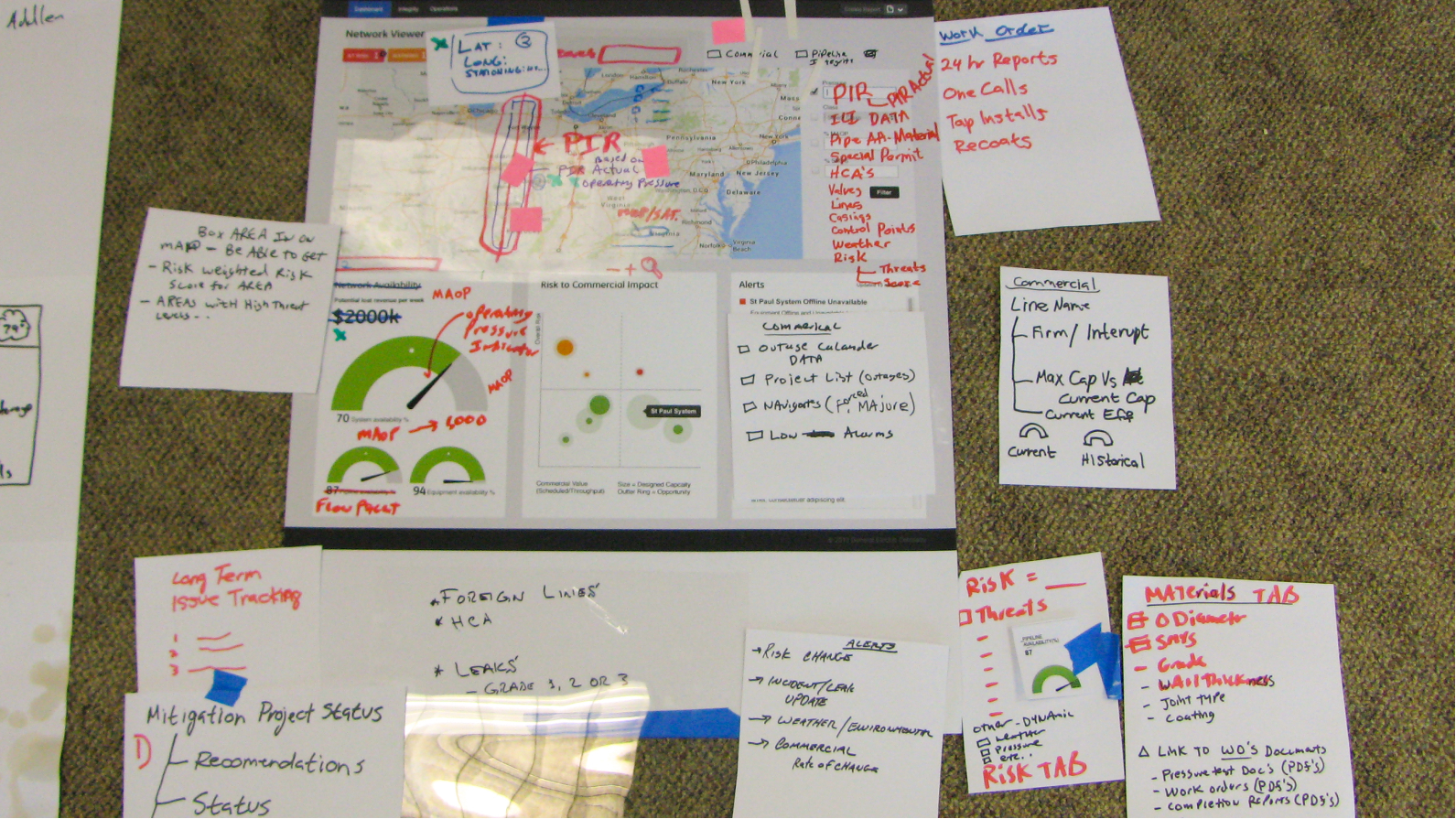Design Strategy + Design thinking
Design sprints
I championed a design sprint program to accelerate product development, break down barriers between teams and customers, and drive design across SLB's global footprint.
Background
I learned how to scale design across organizations as one of the early designers at GE Digital. As the second designer at SLB, I asked, "How am I a design multiplier?" In other words, how might we create and design sustainable change across an organization?
Having established "UX Workouts" at GE, I know how to run design workshops and respond to an organization's cultural, political, and business realities. At GE, I ran workshops that resulted in design initiatives on everything from Intelligent Pipeline Management to human-machine interfaces for power plants.






Design multiplier
But first, we had to win over skeptical engineers and busy stakeholders who felt like the workshops were a waste of time and outside their comfort zones. Soon enough, the multi-day workshop format was getting noticed, and I was running workshops with teams around the globe. With a community of over 2000 engineers, the workshops became a vehicle for design - creating space for creativity and collaboration while delivering tangible results.
As I worked with more and more teams, unique cultural and organizational challenges began to bubble up. I had a first-row seat and saw team after team struggle with innovation and product design. I empathized with brilliant engineering teams who struggled to define "the what" and figure out "how to implement it." Engineering teams excelled at adding features to existing products, and in many cases, it resulted in bloated products that were increasingly feature-rich, complex, and expensive to develop and maintain.
At the C-level, risk was a four-letter word, and product teams mitigated risk by eliminating uncertainty throughout the product development process. Brave subject matter experts (SMEs) sequestered themselves in windowless rooms to create product requirements, specifying everything down to the smallest detail. The attitude towards risk resulted in a development process focused on planning and control, leaving little room for rapid iteration and learning through uncertainty.
Design sprint program
As similar themes emerged from workshop to workshop, I codified them into a series of exercises to create SLB's design sprint toolkit. With the support of two center managers, we kicked off the program with five product teams in Houston. Our initiative piqued interest from senior stakeholders, so we hired a film crew to document the experience and promote the practice. Next, we created an internal website to socialize design practices, house toolkits, best practices, and answer FAQs. I didn't realize it then, but we were about to launch Schlumberger's first design program.
Over the course of the program, I conducted design sprints and train-the-trainer sessions at some of SLB's most prominent tech centers (Houston, Pune, Montpellier, and Oslo). The multi-disciplinary teams loved the workshop format and benefited from customer feedback, decreased time to market, and increased team alignment. Soon enough, our early adopters started clamoring for their own designers, and as the need for design grew, I helped staff design roles and connect teams with design agencies.




50%
of designers ran workshops
63
Workshops within six months
1013
Total participants
The workshops were learning experiences for everyone involved. For example, at the end of each workshop day, I carved out time so that everyone could debrief together. The debriefs provided feedback on the process to improve the team's experience. More importantly, it showed how design amplified listening, mobilized imaginations, and created space to explore new possibilities and start fresh. Design thinking is most potent when it drives business outcomes, inspires new thinking, and teams can leverage the workshop format to design their way through problems.
Business impact
Design sprints have become an essential practice throughout SLB's business, engineering, and design communities. In a self-reported half-yearly survey (2019), 38 out of 76 designers conducted workshops in the first half of 2019. During that time, a total of 63 design sprints/UX workshops were practiced across SLB's 19+ technology centers, engaging approximately 1013 participants in the design process. As an added benefit, the workshops positively addressed the culture of "risk" through design. By designing through risk, teams ritualized exploring new futures, a key ingredient in helping teams sustain innovation.

In my opinion, it's the second and third-order effects that matter most. A well-crafted sprint is fun, promotes group flow, and gets teams excited about getting feedback from users. In one memorable debrief, a developer said, "That was the first time I talked to someone who uses my software in five years." Aha moments like these engage, empower, and transform teams. As teams broke down barriers and engaged end users, the program bridged design and existing organizational processes - enabling teams to address risk through design and channel user feedback into products.
Design as a core competency
Design-centric organizations have demonstrated the return on investment of well-designed products, services, and experiences. The most overlooked aspect of digital transformation is turning design into a core competency, and as companies look to improve customer experiences, many struggle to move design beyond screens.

Today's high-performing teams organize themselves around the customer journey. By staying focused on user needs, they create space to anticipate, explore and adapt to shifts in consumer behavior. I know how to use design to transform teams for organizations looking to make the jump. Imagine operationalizing design and applying the same user-centric perspective to the rest of your business. If you have gotten this far, you can probably tell that I love running design workshops with teams. Whether you are planning your first design sprint or looking for ways to scale design across your organization, I would love to hear your story.
Contributors
Frank Noz | Design Lead & Facilitation
Songwook Song | Visual Design & Film Production